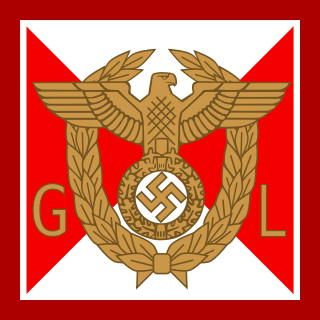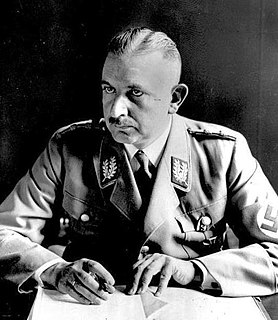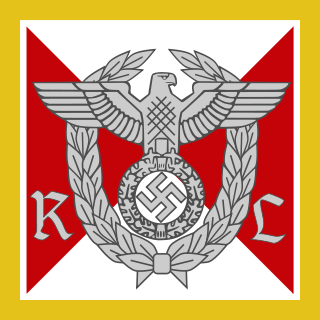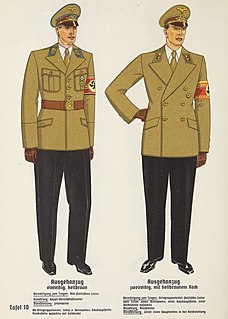
Befehlsleiter (Command Leader) was a Nazi Party political rank of Nazi Germany.

Befehlsleiter (Command Leader) was a Nazi Party political rank of Nazi Germany.
A Befehlsleiter was the highest possible party political rank achievable in the Nazi Party (NSDAP). Only Gauleiter (party official) and Reichsleiter (state appointment) were higher, but these titles were not within the Nazi Party's regular promotional pathway because these positions were only by direct appointment from Adolf Hitler. Until 1939, Kreisleiter and Ortsgruppenleiter , were the fourth and fifth tier of the Nazi Party hierarchy, but they had become titular positions at the outbreak of the Second World War.
Albert Speer, the Reich Ministry of Armaments and War Production, was promoted to Befehlsleiter in 1942 and Oberbefehlsleiter in 1944.

The Nazi Party, officially the National Socialist German Workers' Party, was a far-right political party in Germany active between 1920 and 1945, that created and supported the ideology of Nazism. Its precursor, the German Workers' Party, existed from 1919 to 1920. The Nazi Party emerged from the extremist German nationalist, racist and populist Freikorps paramilitary culture, which fought against the communist uprisings in post-World War I Germany. The party was created to draw workers away from communism and into völkisch nationalism. Initially, Nazi political strategy focused on anti-big business, anti-bourgeois, and anti-capitalist rhetoric. This was later downplayed to gain the support of business leaders, and in the 1930s the party's main focus shifted to antisemitic and anti-Marxist themes.

A Gauleiter was a regional leader of the Nazi Party (NSDAP) who served as the head of a Gau or Reichsgau. Gauleiter was the third-highest rank in the Nazi political leadership, subordinate only to Reichsleiter and to the Führer himself. The position was effectively abolished with the fall of the Nazi regime on 8 May 1945.

Gregor Strasser was an early prominent German Nazi official and politician who was murdered during the Night of the Long Knives in 1934. Born in 1892 in Bavaria, Strasser served in World War I in an artillery regiment, rising to the rank of first lieutenant. He joined the Nazi Party (NSDAP) in 1920 and quickly became an influential and important figure. In 1923, he took part in the abortive Beer Hall Putsch in Munich and was imprisoned, but released early for political reasons. Strasser joined a revived NSDAP in 1925 and once again established himself as a powerful and dominant member, hugely increasing the party's membership and reputation in northern Germany. Personal and political conflicts with Adolf Hitler led to his death in 1934 during the Night of the Long Knives.
This is a list of words, terms, concepts and slogans of Nazi Germany used in the historiography covering the Nazi regime. Some words were coined by Adolf Hitler and other Nazi Party members. Other words and concepts were borrowed and appropriated, and other terms were already in use during the Weimar Republic. Finally, some are taken from Germany's cultural tradition.

Standartenführer was a Nazi Party (NSDAP) paramilitary rank that was used in several NSDAP organizations, such as the SA, SS, NSKK and the NSFK. First founded as a title in 1925, in 1928 it became one of the first commissioned NSDAP ranks and was bestowed upon those SA and SS officers who commanded a unit known as a Standarte, a unit equivalent to an army battalion and comprising 300–500 personnel.

Blockleiter, where block refers to city block, was from 1933 the title of a lower Nazi Party political rank responsible for the political supervision of a neighborhood. Referred to in common parlance as Blockwart, the Block Warden's duty was to form the primary link between the Nazi authorities and the general population. The derogatory term Blockwart ("snoop") survives in German colloquial language.

Ranks and insignia of the Nazi Party were paramilitary titles used by the National Socialist German Workers' Party (NSDAP) between approximately 1928 and the fall of Nazi Germany in 1945. Such ranks were held within the political leadership corps of the Nazi Party, charged with the overseeing of the regular Nazi Party members.

Reichsleiter was the second-highest political rank of the Nazi Party (NSDAP), next only to the office of Führer. Reichsleiter also served as a paramilitary rank in the Nazi Party and was the highest position attainable in any Nazi organisation.

Walter Schimana was an Austrian functionary in the German SS during the Nazi era. He was SS and Police Leader in the occupied Soviet Union in 1942 and Higher SS and Police Leader in occupied Greece from October 1943. Responsible for numerous war crimes and atrocities in the occupied territories, Schimana was arrested by the Allies after the war and committed suicide while awaiting trial.

Zellenleiter was a Nazi Party political title which existed between the years of 1930 and 1945. A Zellenleiter was higher in rank than a Blockleiter and was in charge of a "Nazi Cell", composed of eight to twelve city blocks.
The NSDAP Office of Colonial Policy was a Nazi Party office formed in 1934. Its stated objective was to formulate plans for the re-taking of the former German colonies. The office lost much of its meaning after the start of World War II, and was dissolved after the reversal of Nazi Germany's military victories in 1943.
Abteilungsleiter, German for department head, was also a mid-level administrative political position of the Nazi Party, often held by staff political officers attached to various Gaue throughout Germany. The position of Abteilungsleiter was not an actual Nazi Party political rank, but a title held by a Party member in addition to their formal rank. The position was first created in 1933, after the Nazis had secured power in Germany.

Ortsgruppenleiter was a Nazi Party political rank and title which existed between 1930 and 1945. The term first came into being during the German elections of 1930, and was held by the head Nazi of a town or city, or in larger cities, of a neighbourhood, for the purposes of election district organization. After 1933, through the process of Gleichschaltung, the position of Ortsgruppenleiter evolved into the Nazi leader of a large town or city or of a city district.

Kreisleiter was a Nazi Party political rank and title which existed as a political rank between 1930 and 1945 and as a Nazi Party title from as early as 1928. The position of Kreisleiter was first formed to provide German election district coordination and, after the Nazi assumption of power, the position became one of county municipal government, effectively replacing the traditional German government establishment.

Dienstleiter was a high-ranking Nazi Party political rank of Nazi Germany which existed between 1933 and 1945. The rank was first created after the Nazi assumption of power and served as the second highest rank of the Reichsleitung Nazi Party organizational level, subordinate to the Reichsleiter.

Stellenleiter was a Nazi Party political rank which existed between 1933 and 1938. The rank was created as a mid-level political position intended to replace the older rank of Zellenwart, also known as Zellenleiter. In the early Nazi Party rank organization, the position of Stellenleiter was senior to Mitarbeiter and junior to Amtsleiter.

Gemeinschaftsleiter was a Nazi Party political rank which existed between 1939 and 1945. Created primary to replace the older rank of Stützpunktleiter, the rank of Gemeinschaftsleiter was often used on the local level of the Nazi Party to denote the second in command of a municipal region, answering to a regional Nazi known by the title of Ortsgruppenleiter.

Bereitschaftsleiter was a Nazi Party political rank which existed between 1939 and 1945. There were three levels of the rank, known as Bereitschaftsleiter, Oberbereitschaftsleiter, and Hauptbereitschaftsleiter.

Bereichsleiter was a Nazi Party political rank which existed between the years of 1939 and 1945. The rank of Bereichsleiter was created primarily to replace the older rank of Kreisleiter but was also used on higher levels of the Nazi Party as a senior Chief of Staff position.
Betriebsobmann was a political position of the Nazi Party which existed between the years 1939 and 1945. The term first came into being at the start of World War II and was unique only to the local level of the Nazi Party, known as the Ortsgruppen.